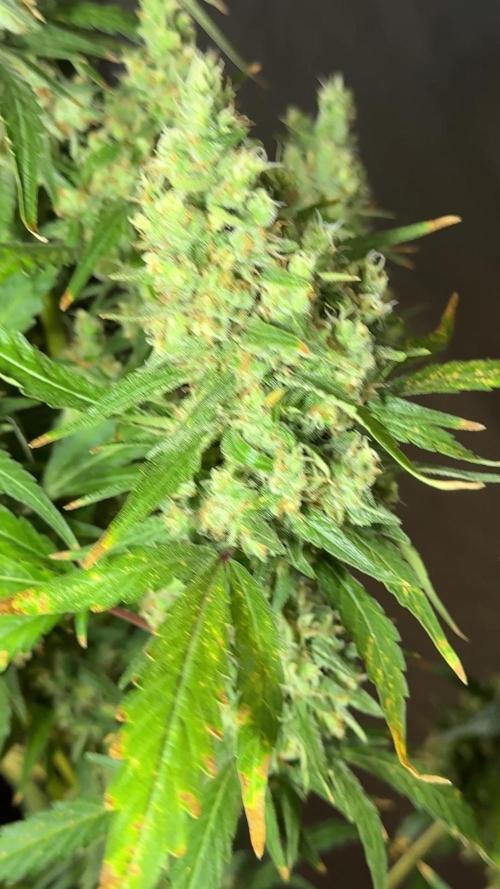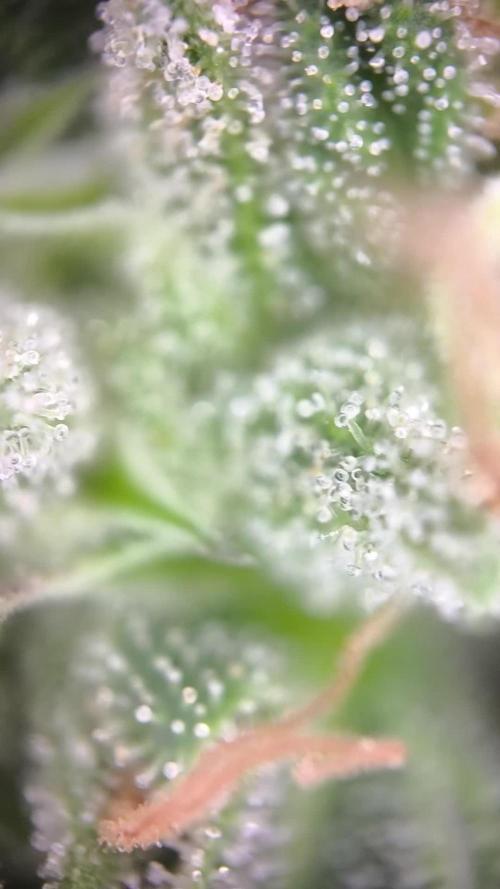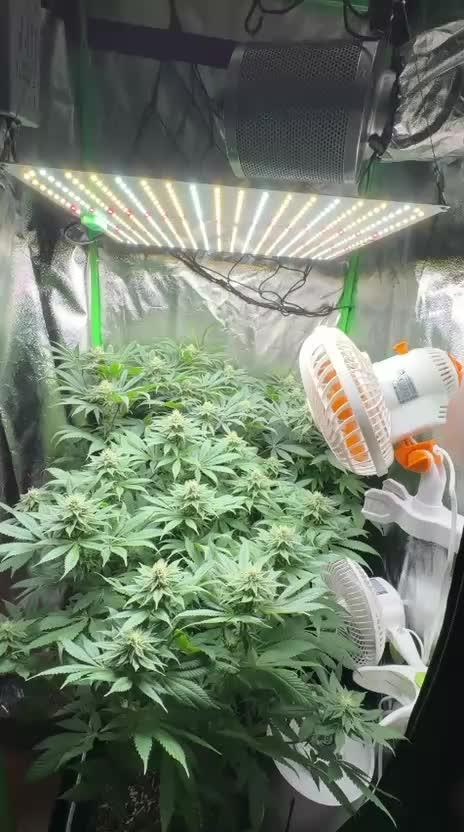The Grow Awards 2026 🏆 



































Likes
Comments
Share


@BruceBlack
Follow
This week they started show va lot of yellow leaves, I was addind some more nutrients since I Think they can still fatten a bit more.
On some of them you can see there are some crunchy leaves , which bothers me a bit.. is it normal?
One of them is not drinking that much water lately so I'm just feeding it with water, hopefully I can harvest it within a week a or less, the rest of them are still drinking a lot so I'll keep feeding them with nutrients but with only 2ml/ Lt
Smell is super strong and even with the carbon filter the whole room smells like poison, hahaha, luckily i the rest of the house smell it's barely noticeable
Looking forward to harvest and finish everything, this last period is has been the toughest cuz I need to know when exactly to start the root wash
Likes
48
Share


@Nvchods3
Follow
transplante a maceta de 5.5 litros
se le aplico microrrizas
mas un potenciador genetico Knactive
Likes
91
Share


@GERGrowDesigns
Follow
Welcome Everyone,
You been just Invited to Take a Seat at the :
-Designers Club -
Special Thanks to John for hopping through my Messages to Join The SSSC/DP Photo Contest
So my part was to Create the "Designers Club".
Its a New Created Fast Version Strain from a Cooperation Between SuperSativaSeedClub and DutchPassion. The Club will Carry 3 of these Phenos .
Information we have About this Strain :
Fast Version B – Indica-Dominant (90%) | 7 weeks flowering | Fruity, Peppery, Sweet
The Project will be Supported from Narcos Nutriets to give the Strain the Perfect lifespan it could Deserve .
Light used for The Contest Grow :
Tenty Pro x4 200w in a space of
60x60 Homebox Ambiente Tent.
Quickly Reminder , this Diarie will be a Time Eater . If you Enjoy what you see just show it with Some Thoughts and Thumbs in the Weeks . I will Appreciate that.
Enough Talk from me , just Enjoy youre Seats and be a part of The Designers Club .
Good Luck to Everybody and Keep up Growing !
Likes
7
Share


@Canadian
Follow
This plant is doing very well she was donated to a Cuban friend I have which actually has two of them and they are very well she is very tall with large branches despite being on a small pot she has been fed nutrients once a week no training has been done on her despite all that she's looking fantastic I did not want to keep her with me because I don't know if they're flowering cycle will be done by the 1st of October if not then rain and humidity is too high to be able to crop something outside in Ontario.
Thank you for reading I will continue to update have a happy grow.
Likes
6
Share


@DogDoctorOfficial
Follow
🌸 Lava Cake – Week 7 Flower (Harvest Special) 🌸
This week marks a major milestone in the Lava Cake journey: we harvested phenotype two, who had been affected by bud rot. Bud rot may have tried to take the best from us, but we didn’t allow it. Every infected part was carefully removed, and the remaining healthy plant was harvested and is now drying as a whole plant under controlled conditions.
⸻
🙏 Apologies & Context
We know this is technically a flower week update, but due to the new updates on Grow Diaries and the desire to share photos, videos, and the story of this harvest so we’re combining the harvest with the flower week report.
We apologize for any confusion — this is the only way to fully document and expose all that’s happening, and to make sure the lessons, successes, and challenges are visible for everyone following along.
The next report will be the official “Harvest Report”, covering:
• Drying & trimming process
• Curing updates
• Smoke review
⸻
🌿 Quick Recap – From Seed to Here
• Germination: Smooth in the Cannakan with Aptus Regulator & Start Booster, 3 seeds, 2 kept.
• Vegetative Stage: Robust growth under Black Series 600 LED and later ThinkGrow & Lumatek LEDs. Root development and early structure supported with Aptus super soil and micro/macro mixes.
• Transplant: Into 11L fabric pots, carefully monitored environment, roots thriving.
• Early Flower: Weeks 1–4 brought thick white hairs, dense colas, and heavy branching. Nutrient support included Aptus Regulator, CalMag Boost, Plagron boosters, and All-in-One Liquid.
• Mid Flower & Challenges: Week 5–6 showed signs of bud rot. Lava Cake #2 needed early harvest; Lava Cake #1 continues to swell and thrive.
Through all of this, the Lava Cakes proved their resilience and quality, showing that even under stress, their genetics shine beautifully.
⸻
🌱 Week 7 – Harvest Details
• Bud Rot Management: All infected material removed and disposed of immediately.
• Harvest Technique: Whole plant harvested, inspected, and prepared for controlled drying.
• Drying: Slow, careful drying in a separate, stable environment to preserve aroma, terpenes, and cannabinoids while minimizing risk.
Even though bud rot forced an early cut, the flowers are still dense, fragrant, and high quality. Their resilience and beauty deserve celebration.
⸻
🔬 Educational Notes
• Bud rot prevention & learning: This week reinforces how crucial airflow, humidity management, and daily inspection are during dense flower stages.
• Whole-plant drying: Allows moisture to equalize gradually between stems and buds, preserving terpenes and flavonoids while keeping the product safe.
• Environmental awareness: Temperature spikes, stagnant airflow, or dense canopy zones can quickly create pockets for mold — constant monitoring is essential.
⸻
🌟 Closing Thoughts
Week 7 is about resilience, lessons, and triumph over challenges. The Lava Cakes showed their strength even under pressure but needed to be harvested early, so we did it, no fears this is the only way and the way to save the rest of the closet sharing girls
We want to celebrate the journey, from seed to harvest, and thank everyone following along for learning and growing with us.
The next report will focus entirely on drying, trimming, and tasting — the final step where we get to enjoy the fruits of all the care, attention, and love put into these girls.
📲 Don’t forget to Subscribe and follow me on Instagram and YouTube @DogDoctorOfficial for exclusive content, real-time updates, and behind-the-scenes magic. We’ve got so much more coming, including transplanting and all the amazing techniques that go along with it. You won’t want to miss it.
• GrowDiaries Journal: https://growdiaries.com/grower/dogdoctorofficial
• Instagram: https://www.instagram.com/dogdoctorofficial/
• YouTube: https://www.youtube.com/@dogdoctorofficial
⸻
Explore the Gear that Powers My Grow
If you’re curious about the tech I’m using, check out these links:
• Genetics, gear, nutrients, and more – Zamnesia: https://www.zamnesia.com/
• Environmental control & automation – TrolMaster: https://www.trolmaster.eu/
• Advanced LED lighting – Future of Grow: https://www.futureofgrow.com/
• Root and growth nutrition – Aptus Holland: https://aptus-holland.com/
• Nutrient systems & boosters – Plagron: https://plagron.com/en/
• Soil & substrate excellence – PRO-MIX BX: https://www.pthorticulture.com/en-us/products/pro-mix-bx-mycorrhizae
• Curing and storage – Grove Bags: https://grovebags.com/
⸻
We’ve got much more coming as we move through the grow cycles. Trust me, you won’t want to miss the next steps, let’s push the boundaries of indoor horticulture together!
As always, this is shared for educational purposes, aiming to spread understanding and appreciation for this plant. Let’s celebrate it responsibly and continue to learn and grow together.
With true love comes happiness. Always believe in yourself, and always do things expecting nothing and with an open heart. Be a giver, and the universe will give back in ways you could never imagine.
💚 Growers love to all 💚
P.S. – Heavy Fruits & Harvest Decision
One of the key reasons we decided to harvest Lava Cake #1 this week was how heavy the colas had become. The flowers were so dense and weighty that some branches were starting to bend, snap, and strain under the load.
While this is a testament to the plant’s vigor and genetics, it also increased the risk of further bud rot and damage, making an early, careful harvest the safest and most sensible choice.
Even under pressure, these girls delivered impressive structure, weight, and resin coverage, proving their strength and quality until the very last moment.
Thank you all for being here with me, see you all on the next report, Growers Love to All and never stop believing
🙏🙏🙏
Likes
54
Share


@rhodes68
Follow
2/5 Week 6
May be last week of veg kind of depends on factors outside the grow. Lets hope
Keeping the Si included and leaving nuets as is.
Continuing to defoliate as needed to keep things civil in the small tent, Moya is crowded.
Canopy is at 30" plants about 20"
2/6
Better plan!
Found a table at Goodwill that will fit in the flower tent and allow two plants to be moved there tomorrow.
So tomorrow is the day, two plants will remain in Moya, prob Jool and Zhaan
2/7 Aeryn is in flower tent flipped to 12-12
Jool and Zhaan in small tent, Moya, also flipped to 12-12
Here we go
Feed set as above, keeping levels low at this point
2/8 Second day
May reduce feed a bit, white tips
One time feed of Kangaroots 10ml/gal
Keeping things defoliated so the middle gets lots of light
2/8 Last attempt to try and get rid of those white tips. Further reduced feed but added just a touch of cal-mag to make up for it.
If this doesnt work I am just feeding them and ignoring the tips.
Flowering is starting to show, more on Aeryn being under the HPS than Jool and Zhaan under the LEDs.
Continuing to defoliate as needed to keep bud sites in light.
2/10 Bringing down the nuets to under 500ppm did the trick on the white tips but can not leave things there so back to some sane level and I am just going to ignore it.
Stretch is starting for real 😳
2/11 Since the tip burning is an issue with N, I am going to move the girls to all bloom tomorrow with today as a transition.
Strain is absolutely sensitive to Nitrogen.
Likes
15
Share


@BalconyBoy
Follow
24.09.25 due to the weather outlook and fear of a powdery mildew revival it was time to harvest. I wet trimmed everything down to the buds and discarted all stems right away. The reason being that I want to accelerated drying and see each nug closely before putting it into the multi tier drying screen im using. In this process some smalls with mildew were identified and sent to compost. After a week flowers were placed in closed plastic buckets to get even moisture content. Further processing awaits.
Likes
3
Share


@Mismatas
Follow
APROXIMADAMENTE CUARTA SEMANA EMPEZAMOS POR PRIMERA VEZ NUESTRO LST Y UNA LIGERA PODA DE BAJOS.
SEGUIMOS CON EL CABLE DE CALOR PUESTO Y TAMBIÉN AÑADIMOS UN CALEFACTOR PARA MINIMIZAR LAS BAJAS TEMPERATURAS
Likes
9
Share


@Dmon013
Follow
The missing star Due to the weight and growth that is different from other numbers But she still has a highlight that is covered with snow Make us all want to have a relationship with this little girl once🍬🍒🍭❄️
This After harvest 14 Day
Living soil🥦🥦
Notill💚💚💚
Likes
6
Share


@GrowerGaz
Follow
Plain sailing this week , just water for the Sweet n Sour and the Blackberry Gum, the Cheesy auto just had one last feed of Iguana Juice and PK booster BAC . Few more days and the SNS and BG should be done.
Likes
12
Share


@CampaCavallo
Follow
Buongiorno amici della canapa 🥦💚
Un grande complimento a tutti i vincitori de AWC🏆🥇
Eccoci alla 6ª settimana di fioritura💐
La Critical Lemon ⚡🍋 sta iniziando a far gonfiare per bene le sue belle cime innevate😍😋
TENT-X 🤖 le tiene sotto controllo egregiamente! 🔝
L'amica Gangi🐊 mi salta in testa ogni volta che apro la porta😱... Mi vorrà mangiare! Pensa di essere un drago di comodo! 😁
Likes
4
Share


@torresgrow
Follow
700 ppm 5.9ph at least day 20/02 then I realize that she was hungry and start up ppm, 900 ppm and get a runoff of 850 ppm
Likes
11
Share


@kauilmayel1996
Follow
Creo que me gustan mucho las semillas automáticas
no son plantas muy grandes pero si son rápidas y con buena pinta
El equipo de fast buds me sorprendió
buena genética
yo pensando que serían las más pequeñas y una gorila glue está con unos cogollos bastante chonchos y cristalinos
super feliz con mis pequeñas auto...
happy grow a todos!
Likes
20
Share


@DrGanj
Follow
Finally starting to reach the SCROG. First time doing this but fingers crossed it goes well!
Likes
3
Share


@Tricomasnqn
Follow
20 días despues, en la semana 8 de vege se ve el gran crecimiento que tuvieron despues del cambio de lampara y el aumento de temperatura, empece a hacer un guiado, sin defoliacion todavía.
Likes
9
Share


@eldruida_lamota
Follow
Que hay familia, estamos de nuevo actualizando, y es que traigo la sexta semana de floración de las Kritical de la web de GrowBarato.
En este diario dejare más imágenes ya que tengo algún ejemplar más.
Van progresando adecuadamente todas sus flores, esta semana añadiré bien de ExplotaCogollos de Agrobeta.
Ya os comenté que estamos en la recta final y una vez solucionadas las carencias solo les queda engordar y compactar bien.
Agrobeta:
https://www.agrobeta.com/agrobetatiendaonline/36-abonos-canamo
Mars hydro:
Code discount: EL420
https://www.mars-hydro.com/
Las maximas de temperatura no superan los 25 grados y las mínimas no bajan 20, así que no me puedo quejar.
Los niveles de humedad también son los correctos van entre 50%/65% de humedad relativa.
Por supuesto el Ph lo estamos dejando alrededor de 6.
Hasta aquí es todo, buenos humos 💨💨💨.
Likes
8
Share


@Silverback_Guerilla
Follow
5/6 - 5/13
Not much stretch, thankfully...just packing on the pistils.
👉 Check out these new XS1000 lights on Amazon: https://amzn.to/3ttb2j9
👉 Get 10% OFF using this coupon code: lt10gdvip
I ended up taking these back outdoors to finish for a week or two..but then brought them back indoors into my closet for their last week.
They produced about 180g of dried bud that I pressed for the rosin. Not the strongest or best tasting strain to smoke, but it made some good goo for dabs.
Likes
2
Share


@Hidden
Follow
Yes, they are really getting big—so much that the grow tent is now completely full. It has been quite a challenge to keep the humidity under control since I don’t have a proper extractor yet (that will definitely be my next purchase). For now, leaving the tent open has allowed the air to circulate well, and the humidity stays around 45%, which is acceptable. Apart from that, everything has been calm and steady, continuing with the BioBizz feeding schedule and gradually increasing the nutrients to encourage the development of larger colas. The only drawback is that the colas are not turning out as thick as I had hoped. Interestingly, RHC #2 and #3, even though they are not the most robust plants, ended up being the tallest ones, and their colas actually look bigger than RHC #1. Overall, I’m happy and counting down the days with excitement.





















